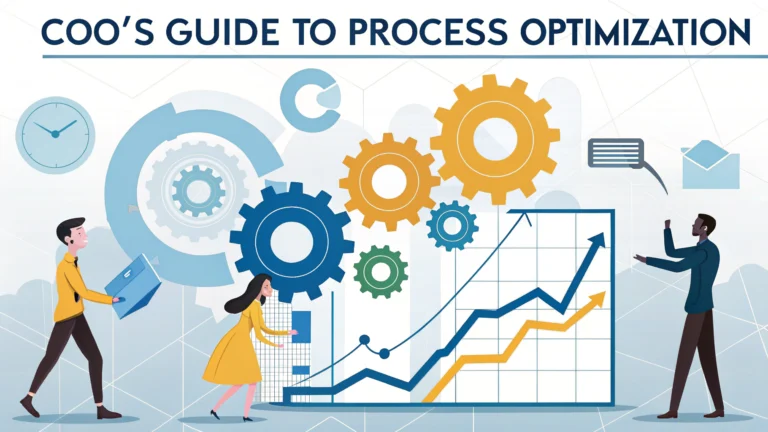Process optimization directly impacts business performance, efficiency, and the bottom line for organizations of all sizes.
As a COO, mastering process optimization techniques enables you to streamline operations, reduce costs, and drive sustainable growth.
This quick guide breaks down practical strategies and proven methodologies to help you optimize your business processes effectively.
Getting Started with Process Mapping
Start by creating detailed process maps for each core business function using tools like Lucidchart or Microsoft Visio.
- Document current workflows step-by-step
- Identify process owners and stakeholders
- Map dependencies between different processes
- Note bottlenecks and pain points
Key Areas for Process Analysis
Focus optimization efforts on these high-impact areas:
| Area | Optimization Focus |
|---|---|
| Operations | Workflow efficiency, resource allocation |
| Supply Chain | Inventory management, supplier relationships |
| Customer Service | Response times, issue resolution |
| Quality Control | Error reduction, compliance |
Data-Driven Decision Making
Implement these measurement tools to track process performance:
- Key Performance Indicators (KPIs)
- Process cycle time metrics
- Cost per unit measurements
- Quality control statistics
- Customer satisfaction scores
Technology Integration
Consider these proven process optimization tools:
- Automation: UiPath, Blue Prism
- Project Management: Monday.com, Asana
- Process Mining: Celonis, ProcessGold
- ERP Systems: SAP, Oracle NetSuite
Change Management Strategies
Follow these steps to implement process changes effectively:
- Create a clear communication plan
- Train staff on new procedures
- Set realistic implementation timelines
- Monitor adoption rates
- Gather feedback and adjust accordingly
Common Optimization Pitfalls
Watch out for these frequent mistakes:
- Optimizing processes in isolation
- Neglecting employee input
- Rushing implementation
- Insufficient testing
- Poor documentation
Next Steps for Success
Contact process optimization consultants through professional networks like LinkedIn or industry associations for specialized guidance.
Schedule regular process reviews (quarterly recommended) to ensure continuous improvement.
Join COO forums and networking groups to share experiences and learn from peers (COO Forum or LinkedIn COO Network).
Measuring Success
Track these essential metrics to evaluate optimization efforts:
- Process cycle time reduction
- Cost savings achieved
- Employee productivity gains
- Customer satisfaction improvements
- Error rate reduction
Advanced Optimization Techniques
Six Sigma Implementation
Incorporate these Six Sigma methodologies:
- DMAIC (Define, Measure, Analyze, Improve, Control)
- Statistical process control
- Root cause analysis
- Value stream mapping
Lean Management Principles
Apply these proven lean concepts:
- Just-in-time production
- 5S workplace organization
- Kanban systems
- Waste reduction strategies
Scaling Optimized Processes
Follow these steps when expanding successful optimizations:
- Document proven workflows
- Create standardized procedures
- Build scalable systems
- Train implementation teams
- Monitor expansion results
Driving Sustainable Process Excellence
Establish a continuous improvement culture through:
- Regular process audits
- Employee suggestion programs
- Cross-functional improvement teams
- Performance recognition systems
- Ongoing education and training
Building Your Optimization Roadmap
Create a strategic implementation plan aligned with business objectives. Focus on quick wins initially to build momentum and stakeholder support. Maintain flexibility to adapt to changing business conditions while staying committed to long-term optimization goals.
Remember that process optimization is an ongoing journey rather than a destination. Stay current with industry best practices and emerging technologies to ensure your organization remains competitive in an evolving business landscape.
FAQs
- What are the key responsibilities of a Chief Operating Officer (COO) in process optimization?
A COO is responsible for overseeing operational efficiency, developing strategic improvement initiatives, managing cross-functional teams, ensuring resource allocation, implementing performance metrics, and aligning processes with organizational goals. - How do COOs effectively identify areas for process improvement?
COOs identify improvement areas through data analysis, performance metrics evaluation, employee feedback, customer satisfaction surveys, process mapping, and regular operational audits. - What are the essential tools and methodologies used in process optimization?
Key tools include Lean Six Sigma, Business Process Management (BPM) software, Value Stream Mapping, SIPOC diagrams, KPI dashboards, and workflow automation platforms. - How should a COO measure the success of process optimization initiatives?
Success is measured through KPIs including cycle time reduction, cost savings, productivity improvements, error rate reduction, customer satisfaction scores, and ROI on process improvements. - What role does technology play in modern process optimization?
Technology enables process automation, real-time monitoring, data analytics, predictive maintenance, digital workflow management, and AI-driven decision support systems. - How can COOs effectively manage resistance to process changes?
COOs should implement change management strategies, ensure clear communication, provide training, demonstrate early wins, involve stakeholders in planning, and create accountability systems. - What are the common challenges in implementing process optimization?
Common challenges include budget constraints, employee resistance, legacy system integration, data quality issues, organizational silos, and maintaining consistency across departments. - How often should processes be reviewed and optimized?
Processes should undergo continuous monitoring with formal reviews quarterly, major assessments annually, and immediate evaluation when market conditions, technology, or business requirements change significantly. - What role does sustainability play in process optimization?
Sustainability considerations include reducing waste, optimizing resource usage, implementing green technologies, ensuring regulatory compliance, and developing environmentally responsible operational practices. - How do COOs balance cost reduction with quality maintenance in process optimization?
COOs must establish quality control metrics, implement cost-benefit analysis, maintain service level agreements, utilize quality management systems, and ensure continuous monitoring of customer satisfaction.
